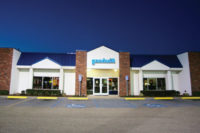Communicate security’s value. Save money. Create business efficiencies. Reduce risk.
Gene James did that and more. He saved Jack in the Box $1.9 million dollars.
James is director of asset protection for Jack in the Box, which is among the nation’s leading fast-food hamburger chains, with more than 2,200 quick-serve restaurants in 19 states. Additionally, through a wholly owned subsidiary, the company operates and franchises Qdoba Mexican Grill, a leader in fast-casual dining, with more than 500 restaurants in 43 states and the District of Columbia.
Some of those restaurants are in high crime areas, including South Central Los Angeles. A few years ago, James got off an airplane in Dallas and checked his cell phone. To his surprise, he had five voicemails, numerous emails and many text messages. “I immediately called my office back in San Diego, and found out that we had a hostage situation in one of our restaurants,” he recalls. “We had a SWAT team in the parking lot and we had hostage takers in the dining room. It truly was a worse case scenario.”
The hostage situation was in one of the company’s restaurants in that South Central Los Angeles. And although Gene was in Dallas, it quickly became his problem.
The good news was that the restaurant had bullet resistant material at the front counter, and the employees were able to escape to the kitchen and lock the door behind them. They were safe, for the moment.
More good news: James and his security team had just installed Westec’s Virtual Guard system with security video cameras in that restaurant – that allowed the SWAT team to listen and talk directly to the employees, confirm their location and help them escape through the restaurant’s back door to safety.
“But we still had 14 customers being held hostage in the restaurant,” James says. “This was troubling, because many of those customers were infants and elderly people.”
James and his staff watched the event unfold together with the SWAT team and listened in on their conversations at the location. “They found out that the suspects had hatched a scheme: they were going to tell the SWAT team they were going to release the hostages, but secretly, they were going to escape by pretending to be a hostage. The guarding system heard the entire conversation and reported it to the SWAT team. When the real hostages were released, three hostage takers were immediately arrested, without incident. On that day we saved lives,” James says.
Today, the system is installed in 115 of Jack in the Box company-owned restaurants in high-crime areas across the U.S. And soon, the system will be installed in an additional 20 restaurant locations. The system can conduct tours of a location, escort employees on and off the premises and ensure the security of a business 24/7. More importantly, it’s a business model that is creating value for Jack in the Box, James and his security team. “We have greatly enhanced the safety and security of our restaurants, employees and guests and with the added benefit of saving millions of dollars a year,” he says.
It’s also helped James and his team transition from being heavy in investigations to doing more preventive and proactive security work. If someone goes into a Jack in the Box restaurant and acts suspicious, the employees only have to use the system and the situation can be handled quickly.
Also helping to reduce risk in the restaurants are “Under Surveillance” signs and audio warnings.
“My job description actually begins with the words: ‘Personally responsible for the safety and security of every guest and every employee at Jack in the Box,’” James adds. “That’s a very powerful statement. From that statement I look to technologies to help me accomplish that goal.”
James says that future plans include using the system to identify and prevent sales manipulation by integrating Westec into the Jack in the Box point of sale system in 10 restaurant locations, in an effort to prove the concept and with the intention of creating a system-wide sales enhancing resource.
Finding the New Model
The guarding system that Jack in the Box uses is just one example of a new business model for guarding services. According to a report by Robert Perry & Associates, White Paper on the U.S. Security Guard Industry, some guarding companies – not all – are stepping away from offering only traditional manned services. According to the report, “Many of the larger companies are getting into the remote video monitoring business as a way to supplement or enhance the existing traditional standing guard service. Some are also pursuing the background screening business, ‘Alert Line’ services, executive protection, etc. – all as a way to diversify and get more competitive and, in a lot of instances, set themselves apart from their strongest competitor in the traditional standing security guard market.”
Some companies are also supplementing security officers with additional forms of security and reinventing themselves to be successful. Says the report, “A [recent] article… cited a police department in a New Jersey city that installed video equipment to supplement its police force. This could point to a trend that will carry over into the private security sector. However, in most instances companies are not actually cutting back on manned security but are supplementing the security function by installing cameras, alarms, etc. as a way to enhance the existing security. As a result…many security guard companies are starting a separate electronics division or partnering with an existing electronics company.”
So increasingly, traditional business models for securing an organization, school, hospital or other facility are changing to provide more business value to an organization. Such is the case at Cox Enterprises in Atlanta, where G4S security officers do more than simply guard the premises; they create business value.
Cox Enterprises is a leading communications, media and automotive services company. With yearly revenues approaching $15 billion, businesses include Cox Communications, a cable TV and broadband provider; Manheim, a vehicle wholesale marketplace; AutoTrader.com, an automobile classified and consumer information Internet site; and Cox Media Group, a broadcasting, publishing and digital media company.
The enterprise has office and data center locations within a few miles of each other in and around Atlanta, with an additional data center in Phoenix. Some 85 security officers are contracted to work at various Cox Enterprises sites; about a third of them work at the company’s corporate headquarters in Sandy Springs, GA.
On the most basic level, security officers man the front desk, complete roving patrols, handle employee badging, administer security systems and maintain a 24-hour security control center that receives communication from security officers stationed throughout the enterprise. A Honeywell Pro-Watch system combines video (from an assortment of video management systems), access control and other security systems.
Management of sensitive and expensive inventory is another responsibility of the security officers. They receive and track any packages that arrive at the loading dock or warehouse and move through the data centers. In addition to securing the costly computer hardware, officers protect server equipment that could potentially contain personal data.
Moving further beyond basic guarding responsibilities, the officers are trained as first responders to manage emergency response and medical emergencies. Security officers have responded to medical emergencies at Cox, providing automated external defibrillator (AED) assistance, checking vital signs and offering comfort while waiting for emergency services.
Technology expands the capabilities of the security officers, adding business value to the solution. At Cox Enterprises, officers utilize handheld devices, which enable them to interact in real time, send pictures instantly and provide additional information to the centralized command center.
“The system transforms them from security officers to serve as the eyes, ears and face of Cox Enterprises,” says Duane Ritter, vice president of corporate security for the company. “They can notify us immediately of anything happening throughout the company. I depend on those folks to do their jobs and on G4S to make sure they have the right tools and are properly trained.”
The system transforms a simple guard tour into an ongoing source of valuable information about Cox and available throughout the company. For example, a security officer can record the humidity level in a Cox Enterprises data center, check pressure value information of an air-conditioning system or confirm that fire extinguishers have been properly charged. In addition, the system can provide officers with a list of questions, which officers can answer by inputting data from any location on their tour. If reported data falls outside expected parameters, the system can alert Cox management with an alarm. These duties expand the effectiveness of security officers, boost their job satisfaction and help Cox to create business efficiencies.
“We are a company with more than 60,000 employees, including several large business units,” says Ritter. “We want to be as efficient as possible.”
On Foot and on Wings
What gets Brian Hitch excited is his new Segways for his 18 uniformed guards that are helping his patrol officers to respond to emergency situations faster and with less physical exertion for more effective response. The cost of the Segways, he says, is justified, because his officers are able to cover more territory and deal with situations more quickly. The result is a more secure campus.
Hitch is head of security for the University of Tennessee Medical Center in Knoxville, Tenn., a Level 1 Trauma Center. Hitch and his security team provide for the safety and welfare of everyone in the facility. Uniformed officers and marked patrol vehicles secure and protect the patients, families and employees. They also provide support services such as aiding distressed motorists, managing crowds, directing traffic and offering safety escorts.
“We usually answer about 34,000 calls a year for service,” Hitch explains. “That can be as simple as opening a car door or dealing with a violent person.”
Hitch has as many as 7,500 cars a day on the medical center campus, with parking spaces that rotate out five times a day. The Segways help his officers patrol the campus more quickly and effectively, and deal with a traffic issue with cars backed up from the campus onto a highway. “As soon as we got the Segways the traffic issue stopped,” he says. “We are just able to deal with traffic issues faster. The Segways our guards use are averaging 18 miles a day over the parking lots and garages. It really gets us out there faster to prevent crime.”
Leading the Way
There are many outstanding examples of guarding programs that are creating new business models – whether they use a Segway or not. But most important, says ASIS President Ray O’Hara, is justifying the expense.
“The challenge for a security manager is to absorb the technology and then validate that it works for them,” he says. “The goal is to create a hybrid model of protection rather than just saying ‘We need 30 security officers.’ Actually you might need only 20 because the technology those officers use replaces the other ten. So do some benchmarks and find ways to push efficiency using the dollars you have at hand. Find the business case to take to the C-suite.”
Daniel Luitjens, director of corporate security for Henkel North America, agrees. “The technology has to have value to the business,” he says. “Just giving our security guards a Segway doesn’t mean they will do a better job. It has to be justified. For example, some alarms are pushed to a guard’s cell phone for him to respond. We’ve found there are security guards who are very comfortable with that technology, and in some cases, it helps them to be more effective with their job. But it may not be the case with everyone.”
“My primary focus is people and asset protection,” Luitjens explains. “In that situation, a lot of what we do doesn’t have an ROI, but you still have to do it. So any enhancements to the security function need to be justified. We always consider new technologies that will help our security staff, because sometimes it can enhance it and make the business work better.”
|
How Technology Solutions Can Increase ROI for Security Programs
By David Feeney, IT Director of Integrated Solutions, AlliedBarton Security Services In today’s economic environment, two things have gained more emphasis and become more challenging to attain: security and cost savings. Because the two are traditionally contradictory, it is all the more critical for organizations to make security investments rather than security expenditures. The difference between the two is return on investment (ROI); investments have it, and expenditures don’t. Starting a security project or initiative by first considering the solution can result in expenditures rather than investments. To increase potential ROI, start by identifying a problem or opportunity. Then list the goals related to this problem. Goals that indicate potential ROI include increasing effectiveness, saving time, simplifying operations or becoming more efficient. Solutions that match your problem and goals are more likely to provide ROI. Let’s look at some strategic investments that commonly provide an ROI based on these goals.
Problem: Incident reports are sometimes lost, difficult to locate, inconsistent and ineffective at providing actionable intelligence. Solution: Centralized, Electronic Incident Management Systems increase efficiency and effectiveness while reducing risk exposure through increased reliability. Many solutions also allow for analyzing incident trends such as time, day and location. This analysis provides actionable intelligence to increase operational effectiveness. AlliedBarton partners with D3 Security and iView Systems to incorporate this technical solution into our clients’ operations.
Problem: Visitor logs are unreliable, illegible, time-consuming and unable to provide actionable intelligence. Solution: Visitor Management Systems allow for self-service kiosks, check-in by scanning drivers’ licenses or other identification, check-out by scanning badges with handheld PDAs and assignment of temporary limited access control. iView Systems, EasyLobby and others have been called upon to incorporate visitor management systems based on our clients’ requirements.
Problem: Emergency response procedures are cumbersome, excessively manual, inefficient and ineffective. Mass messaging is unreliable and inconsistent. Solution: Notification Management systems allow for consistent messaging to thousands of personnel in a matter of seconds. Some solutions allow for polling recipients for responses, automatic escalation and transferring recipients to conference bridges. AlliedBarton partners with Everbridge to offer this solution.
Problem: Security personnel are not mobile, tied to specific locations and restricted by lack of vehicles. Solution: Officers can be equipped with handheld PDAs to increase mobility. Mobile applications are now available with a growing number of security solutions, including Guard Tour Management solutions that allow for scheduling officer routes, documenting compliance and collecting information about checkpoints for future analysis. D3 Security and Timekeeping Systems offer solutions to meet these needs. Mobility vehicles can reduce time between checkpoints, allowing officers to complete more routes with increased visibility and accessibility. The reduced need for traditional motor vehicles adds to the ROI. AlliedBarton has relationships with T3 Mobility and Segway to incorporate mobility vehicles into our security programs.
Well-integrated technology solutions can help security teams become even more efficient and ultimately, increase your ROI. The key is to identify the solutions that will best meet your specific needs and evolve with you as your goals change. |







